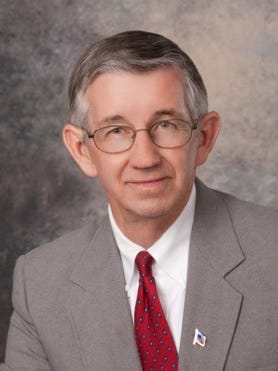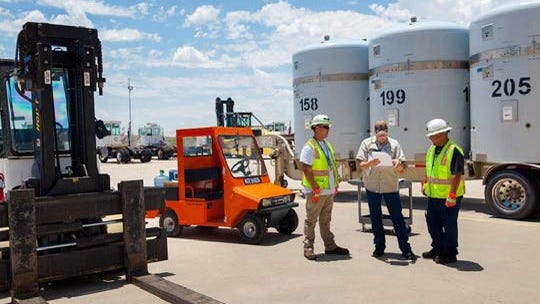A new subcontractor was hired to complete a rebuild of the ventilation system at the Waste Isolation Pilot Plant nuclear repository near Carlsbad after months of legal issues with the past subcontractor who was terminated last fall.
With the new subcontractor award, the project’s original completion date of 2021 was pushed back by four years and it was expected to cost at least $28 million more than the initial contract.
Critical Applications Alliance (CAA) received the initial $135 million contract in November 2018 to build the Safety Significant Confinement Ventilation System (SSCVS) intended to improve airflow in the underground where low-level transuranic (TRU) waste consisting of radiated clothing materials and equipment is permanently entombed in a subterranean salt deposit.
More:WIPP: Restart of ventilation fan needed for worker safety at nuclear repository
Increase airflow was needed after an accidental radiological release in 2014 contaminated parts of the underground, restricting available air and preventing mining, maintenance and waste emplacement operations from being conducted in tandem.
About two years after the initial contract was awarded, WIPP’s primary operations contractor Nuclear Waste Partnership terminated CAA’s contract on August 31, 2020 amid numerous redesigns after the project began.
CAA subsequently sued NWP in federal court for $32 million, alleging a breach of contract and non-payment of multiple invoices.
More:DOE planning to increase down-blended plutonium shipments to Waste Isolation Pilot Plant
In its complaint, CAA alleged NWP owed the company up to $12 million in unpaid invoices and sought additional damages for “improper” termination of the contract
That case was stayed April 13 by U.S. District Judge Kenneth Gonzalez in the District of New Mexico as the parties entered mediation.
Another lawsuit was filed by Christensen Building Group, the parent company of CAA, in December 2020 again against Nuclear Waste Partnership alleging the Christensen was never paid for the construction of fabrication building intended to aid in construction of SSCVS.
More:‘Sparking’ nuclear waste drum at Los Alamos National Lab leads to evacuation at WIPP
That suit argued NWP owed Christensen Building Group $446,164 in unpaid invoices plus interest and attorney’s fees.
A settlement conference in that case was set for April 26, records show, with United States Magistrate Judge Gregory Wormworth presiding.
New contract awarded; project complete by 2025
On Wednesday, NWP and the U.S. Department of Energy Announced the SSCVS project was to be completed by Colorado-based The Industrial Company (TIC) under a $163 million contract to complete construction by 2025.
More:Checking in: WIPP maintenance work ‘on schedule’ during 2-month operations pause
The new completion date marked a four-year delay from the original completion date of 2021 announced when CAA was awarded the contract in 2018 and a $28 million increase in price from the initial $135 million subcontract for the work.
NWP President Sean Dunagan expressed optimism for TIC’s award and said he was confident the company could complete the project.
“We are extremely pleased to bring TIC onboard,” said NWP President and Project Manager Sean Dunagan. “After an exhaustive and thorough procurement process, we believe TIC is the right contractor to complete the largest construction project at WIPP in almost three decades.”
More:WIPP: Hearing planned for new utility shaft amid fears it could extend nuke waste disposal
The SSCVS, the largest fan system among DOE facilities was designed to run continuously unfiltered or using high-efficiency particulate air (HEPA) filters to provide up to 540,000 cubic feet per minute (cfm) of airflow to the underground.
Current ventilation at WIPP provides just 170,000 cfm of air for underground workers to breathe and the increase was necessary, officials argued, to ensure safe operations of diesel vehicles and other equipment in the underground.
Airflow to boost operations at WIPP
With the increased air, WIPP personnel will be able to mine new spaces for waste emplacement, engage in rock bolting to stabilize salt creep, emplace waste and conduct scientific experiments in the underground.
More:Waste Isolation Pilot Plant aims to expand underground facility to hold nuclear waste
While the project is completed, WIPP officials intended to use a ventilation fan to provide some increased airflow – about 90,000 cfm – for a total of 240,000 cfm of available air at the facility.
Testing was recently completed to study the fan’s use after it was paused due to potential contamination following the 2014 event, and radiation release was found to minimal and well below regulatory limits.
TIC Executive Vice President John Jennings said the SSCVS project was essential to worker safety at WIPP, and the company intended to finish the work to the benefit of the DOE’s mission to clean up waste from nuclear sites around the country.
More:Staffing, scheduling problems imperil projects at Waste Isolation Pilot Plant, report says
“TIC is excited to have the opportunity to partner with NWP and complete the construction of the new WIPP Ventilation System,” Jennings said. “We understand the importance of the safe and efficient completion of the SSCVS project and how it will support the Department of Energy’s mission for the WIPP facility.”
Improved air quality and flows at the facility saw support by local leaders in Carlsbad as a measure to protect workers, many of which reside in the city and surrounding communities.

“We support all efforts to improve the ventilation in the WIPP underground. This project will make the underground safer for the WIPP workforce for many years to come,” said Carlsbad Mayor Dale Janway.
“We welcome The Industrial Company and its employees to our community and look forward to showing them all that Carlsbad has to offer.”
Adrian Hedden can be reached at 575-618-7631, achedden@currentargus.com or @AdrianHedden on Twitter.







